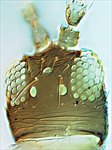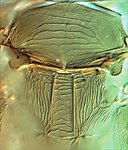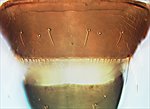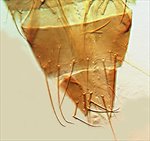
loti head

loti meso & metanota

yunnanensis antennal segments IV-VIII

loti antennal segments V-VIII

loti tergite VIII

loti male genitalia

bifurcus holotype tergites IX-X
Generic diagnosis
Female macropterous. Head as long as wide; maxillary palps 3-segmented; compound eyes usually with 5 pigmented facets; ocellar setae I present, setae III long; five pairs of postocular setae. Antennae 8-segmented, segment I with paired dorso-apical setae, III–IV with sense-cones forked, III–VI with some rows microtrichia on both surfaces, inner sense-cone on VI with broad base sometimes more than 50% as long as total sense cone length. Pronotum wider than long; two pairs of long posteroangular setae; four pairs of posteromarginal setae. Mesonotum with median pair of setae situated near posterior margin, campaniform sensilla present or absent. Metanotum weakly reticulate; median pair of setae at anterior margin; campaniform sensilla present. Fore wing first vein with setal row nearly complete but with sub-apical short gap in setal row; second vein with setae equally spaced; clavus with five veinal and one discal setae; posteromarginal fringe cilia wavy. Prosternal ferna not divided; basantra membranous, without setae; prospinasternum broad and transverse. Mesosternum with sternopleural sutures reaching anterior margin; endofurca with spinula. Metasternal endofurca without spinula. Tarsi 2-segmented; fore tibiae with 0–2 apical claws. Tergites without ctenidia or craspeda; VIII with irregular group of microtrichia anterolateral to each spiracle, posterior margin with comb present laterally but not medially; tergite IX with two pairs campaniform sensilla, MD setae present; X with longitudinal split distally. Sternites without craspeda or discal setae; III–VII with three pairs of posteromarginal setae, II two pairs.
Male similar to female; tergite IX with pair of stout setae at posterior margin; sternites without pore plates.
Biological data
With the exception of one species from North America, all members of this genus apparently breed only in the flowers of Fabaceae, and some Odontothrips species have a high level of host specificity.
Distribution data
Essentially Palaearctic in distribution, this genus has been recorded in China mainly from the northern Provinces but also from the mountains of Yunnan.
Nomenclatural data
Odontothrips Amyot & Serville, 1843: 642. Type species Thrips phaleratus Haliday 1836, by subsequent designation of Karny, 1907.
There are 35 species placed in this genus (ThripsWiki, 2020), but some of the following 11 species listed from China that are based only on females are likely to be synonyms (for example bifurcus that is based on an aberrant individual):
bifurcus Hu & Feng, 2017: 178.
biuncus John, 1921: 7.
confusus Priesner, 1926: 223.
hani Hu, Mirab-balou, Chen & Feng, 2012: 58.
intermedius (Uzel, 1895: 114). (Physopus)
loti (Haliday, 1852: 1108). (Thrips)
meliloti Priesner, 1951: 358.
mongolicus Pelikan, 1985: 130.
pentatrichopus Han & Cui, 1992: 422.
phaseoli Kurosawa, 1941: 36 (43)
yunnanensis Xie, Zhang & Mound, 2010: 55.
Relationship data
Thripidae sub-family Thripinae: this is a diverse group involving more than 230 genera. Closely related both in structure and biology to the Palaeotropical genus, Megalurothrips, and to the Australian genus, Odontothripiella, most species in these three genera can be securely diagnosed only from the structure of the males. The species of these three genera all have a pair of dorso-apical setae on the first antennal segment, a character state that distinguishes them from most Thripinae.
References
Hu QL, Mirab-balou M, Chen XX & Feng JN (2012) A new species and two new synonyms from China in the genus Odontothrips (Thysanoptera: Thripidae). Zootaxa 3259: 58–63.
Pitkin BR (1972) A revision of the flower-living genus Odontothrips Amyot & Serville. Bulletin of the British Museum (Natural History) (Entomology) 26: 371–402.
ThripsWiki (2020). ThripsWiki - providing information on the World's thrips. <http://thrips.info/wiki/Main_Page>
Xie Y-H, Zhang H-R & Mound LA (2010) A new species from southwestern China of the holarctic genus Odontothrips (Thysanoptera: Thripidae). Zootaxa 2729: 53–57.